Comba Telecom Network Systems RD-2020 RD2020 AWS Bandwidth Adjustable Repeater User Manual RD 2020 QI 1 0 0
Comba Telecom Ltd. RD2020 AWS Bandwidth Adjustable Repeater RD 2020 QI 1 0 0
PX8RD-2020 User manual

INSTALLATION GUIDE FOR RD-2020
RD-2020 CDMA QI Copyright - refer to title page Page 1
ENU Status : 1-0-0
RD-2020
CDMA AWS BANDWIDTH ADJUSTABLE
REPEATER
INSTALLATION GUIDE
The information contained herein is the
responsibility of and is approved by the
following, to whom all enquiries should
be directed in the first instance:
Comba Telecom Ltd.
This is an unpublished work the copyright in which vests in Comba International ("Comba"). All rights reserved.
The information contained herein is confidential and the property of Comba and is supplied without liability for errors or
omissions. No part may be reproduced, disclosed or used except as authorised by contract or other written permission. The
copyright and the foregoing restriction on reproduction and use extend to all media in which the information may be embodied.
INSTALLATION GUIDE FOR RD-2020
RD-2020 CDMA QI Copyright - refer to title page Page 2
ENU Status : 1-0-0
0.2 CONTENTS
Section Page
0.2 CONTENTS ...........................................................................................................................2
0.3 INDEX TO FIGURES AND TABLES .....................................................................................3
0.4 HISTORY ...............................................................................................................................4
0.5 GLOSSARY OF TERMS........................................................................................................5
0.6 SAFETY NOTICES AND ADMONISHMENTS ......................................................................6
1 GENERAL INFORMATION....................................................................................................7
2 EQUIPMENT DESCRIPTION................................................................................................8
2.1 RD-2020 FUNCTIONAL BLOCK DIAGRAM .........................................................................8
2.2 EQUIPMENT LAYOUT ..........................................................................................................9
2.3 EQUIPMENT CONSTITUTION ...........................................................................................10
2.4 KITS OF PART.....................................................................................................................11
3 INSTALLATION ...................................................................................................................12
3.1 WARNINGS AND ALERTS..................................................................................................12
3.2 SITE PLANNING CONSIDERATIONS ................................................................................13
3.2.1 INSTALLATION CHECKLIST ..............................................................................................14
3.3 INSTALLATION PROCEDURES.........................................................................................15
3.3.1 GOODS INWARDS INSPECTION ......................................................................................15
3.3.2 INSTALLATION TOOLS ......................................................................................................15
3.3.3 MOUNTING RACK ..............................................................................................................15
3.3.4 LIFTING LUG INSTALLATION ............................................................................................16
3.3.5 WALL MOUNTING DETAILS ..............................................................................................16
3.3.6 POLE MOUNTING DETAILS...............................................................................................17
3.3.7 ATTACHING EQUIPMENT ONTO MOUNTING RACK ......................................................18
3.3.8 DRIP-LOOP .........................................................................................................................18
3.4 EQUIPMENT CONNECTORS.............................................................................................19
3.5 EQUIPMENT CONNECTIONS............................................................................................19
3.5.1 GROUNDING CONNECTION .............................................................................................19
3.5.2 SERVICE VOLTAGE CONNECTION..................................................................................20
3.5.3 LI-ION BATTERY CONNECTION .......................................................................................20
3.5.4 RF CABLE CONNECTION ..................................................................................................20
3.5.5 EXT_ALM CONNECTION ...................................................................................................21
3.5.6 RJ45 WATERPROOF CABLE CONNECTION ...................................................................21
3.6 PREPARATION FOR REMOTE CONTROL OF EQUIPMENT USING MODEM ...............23
4 COMMISSIONING ...............................................................................................................24
4.1 PRE-COMMISSIONING ......................................................................................................24
4.2 MCU LED INDICATORS......................................................................................................24
4.3 WEB OMT ............................................................................................................................25
4.3.1 CONNECTION FROM PC TO EQUIPMENT ......................................................................25
4.4 COMMISSIONING PROCEDURE.......................................................................................28
5 MAINTENANCE...................................................................................................................30
5.1 O-RING FITTING DETAILS.................................................................................................30
6 APPENDICES......................................................................................................................31
6.1 APPENDIX A: TOOLS AND EQUIPMENT FOR INSTALLATION.......................................31
6.2 APPENDIX B: SERVICING POLICY AND RETURN OF EQUIPMENT..............................32
6.3 APPENDIX C: RMA (RETURN MATERIAL AUTHORIZATION) FORM .............................33
INSTALLATION GUIDE FOR RD-2020
RD-2020 CDMA QI Copyright - refer to title page Page 3
ENU Status : 1-0-0
0.3 INDEX TO FIGURES AND TABLES
Figure 1: Front, Side and Bottom Views of Enclosure ................................................................................... 7
Figure 2: Functional Diagram ......................................................................................................................... 8
Figure 3: Layout of Equipped Product............................................................................................................ 9
Figure 4: Mounting Rack Dimension ............................................................................................................ 15
Figure 5: Attach the Lifting Lug to the Enclosure ......................................................................................... 16
Figure 6: Wall Mounting Overview ............................................................................................................... 16
Figure 7: Pole Mounting Overview ............................................................................................................... 17
Figure 8: Attaching the Equipment onto the Mounting Rack........................................................................18
Figure 9: Equipment Connectors.................................................................................................................. 19
Figure 10: Pins Allocation for 7-pin EXT-ALM Connector............................................................................ 21
Figure 11: RJ45 Waterproof Cable Plug ...................................................................................................... 22
Figure 12: Wireless Modem ......................................................................................................................... 23
Figure 13: MCU LED Indicators ................................................................................................................... 24
Figure 14: PC Protocol Setting..................................................................................................................... 25
Figure 15: Log in........................................................................................................................................... 25
Figure 16: Alarm Information........................................................................................................................ 26
Figure 17: User Info& Maintenance.............................................................................................................. 26
Figure 18: Equipment Information ................................................................................................................ 27
Figure 19: General Information .................................................................................................................... 27
Figure 20: Configuration............................................................................................................................... 27
Figure 21: Current Status ............................................................................................................................. 28
Figure 22: O-Ring Fitting Details .................................................................................................................. 30
Table 1: RD-2020 KOP ................................................................................................................................ 11
Table 2: RD-2020 Connectors...................................................................................................................... 19
Table 3: External Alarm Signal Definition..................................................................................................... 21
Table 4: Voltage Applied to EXT Alarm Pin.................................................................................................. 21
Table 5: LED Description ............................................................................................................................. 24
Table 6: IP Setting Quick Look-up Table ..................................................................................................... 26
Table 7: Commissioning............................................................................................................................... 29
INSTALLATION GUIDE FOR RD-2020
RD-2020 CDMA QI Copyright - refer to title page Page 4
ENU Status : 1-0-0
0.4 HISTORY
Change No. ENU Details Of Change
1 1-0-0 This manual first created in July 2010.

INSTALLATION GUIDE FOR RD-2020
RD-2020 CDMA QI Copyright - refer to title page Page 5
ENU Status : 1-0-0
0.5 GLOSSARY OF TERMS
Abbreviation Definition
ALC Automatic Level Control
ATT Attenuator
BTS Base Transceiver Station
dB Decibel
dBm Decibels relative to 1 milliwatt
DL Downlink
DT Donor Terminal
DPX Duplexer
FS Frequency Selection
Hz Hertz
ID Identification
LNA Low Noise Amplifier
MCU Main Control Unit
MHz Megahertz
MT Mobile Terminal
MTBF Mean Time Between Failures
NF Noise Figure
OMC Operation & Maintenance Center
OMT Operation & Maintenance Terminal
PLL Phase Locked Loop
PSU Power Supply Unit
RF Radio Frequency
SMA Sub-Miniature A Connector
SMS Short Message Service
UL Uplink
VAC Volts Alternating Current
VDC Volts Direct Current
VSWR Voltage Standing Wave Ratio
WCDMA Wideband-Code Division Multiple Access
INSTALLATION GUIDE FOR RD-2020
RD-2020 CDMA QI Copyright - refer to title page Page 6
ENU Status : 1-0-0
0.6 SAFETY NOTICES AND ADMONISHMENTS
This document contains safety notices in accordance with appropriate standards. In the interests of
conformity with the territory standards for the country concerned, the equivalent territorial admonishments
are also shown.
Any installation, adjustment, maintenance and repair of the equipment must only be carried out by trained,
authorised personnel. At all times, personnel must comply with any safety notices and instructions.
Specific hazards are indicated by symbol labels on or near the affected parts of the equipment. The labels
that conform to international standards are triangular in shape, and are coloured black on a yellow
background. An informative text label may accompany the symbol label.
Hazard labeling is supplemented by safety notices in the appropriate equipment manual. These notices
contain additional information on the nature of the hazard and may also specify precautions.
Warning Notices:
These draw the attention of personnel to hazards that may cause death or injury to the operator or others.
Examples of use are cases of high voltage, laser emission, toxic substances, point of high temperature,
etc.
Alert Notice:
These draw the attention of personnel to hazards that may cause damage to the equipment. An example
of use is the case of static electricity hazard.
Caution notices may also be used in the handbook to draw attention to matters that do not constitute a risk
of causing damage to the equipment but where there is a possibility of seriously impairing its performance,
e.g. by mishandling or gross maladjustment. Warnings and Cautions within the main text do not
incorporate labels and may be in shortened form.
This device complies with Part 15 of the FCC Rules. Operation is subject to the condition that this device
does not cause harmful interference.
Caution: The user is cautioned that changes or modifications not expressly approved by the party
responsible for compliance could void the user's authority to operate the equipment.
NOTE: This equipment has been tested and found to comply with the limits for a Class A digital device,
pursuant to Part 15 of the FCC Rules. These limits are designed to provide reasonable protection against
harmful interference when the equipment is operated in a commercial environment. This equipment
generates, uses, and can radiate radio frequency energy and, if not installed and used in accordance with
the instruction manual, may cause harmful interference to radio communications. Operation of this
equipment in a residential area is likely to cause harmful interference in which case the user will be
required to correct the interference at his own expense.
To comply with FCC RF exposure requirements, the device and the antenna for this device must be
installed to ensure a minimum separation distance of 2.84 meters or more from a person's body. Other
operating configurations should be avoided.
End of section
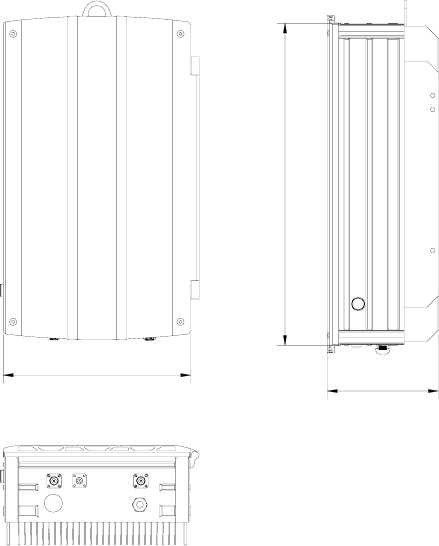
INSTALLATION GUIDE FOR RD-2020
RD-2020 CDMA QI Copyright - refer to title page Page 7
ENU Status : 1-0-0
1 GENERAL INFORMATION
The RD-2020 CDMA AWS bandwidth adjustable repeater is designed for operation in the CDMA network
for AWS band. Band specific linear amplifier and filtering effectively amplifies the desired Node B carrier
and provides superior out-of-band rejection. Typical units with adjustable bandwidth are programmed to
specific requirements of the network. Remote configuration and surveillance is possible through Comba’s
remote control and monitoring system, via PC or wireless modem to the OMC. Internal Li-ion battery
backup ensures alarm signals are sent out in the event of power failure. The RD-2020 comes in a sealed,
well-ventilated cast aluminum enclosure, suitable for all weather conditions.
Main Features:
RD-2020 is a high quality repeater with the following features:
• Integrated wireless modem for remote configuration, monitoring and control (Optional).
• Internal backup battery keeps the alarm unit running for up to three hours in the event of power failure
(Optional).
• OMC is available for remote operation and maintenance. (Optional)
• Designed for all outdoor installation - waterproof, damp-proof and omni-sealed (IP65).
615
200
330
Figure 1: Front, Side and Bottom Views of Enclosure
End of section
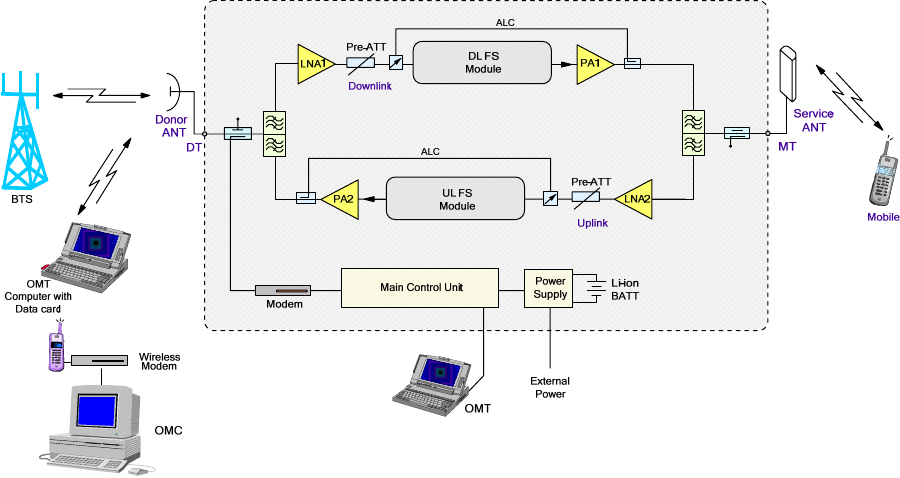
INSTALLATION GUIDE FOR RD-2020
RD-2020 CDMA QI Copyright - refer to title page Page 8
ENU Status : 1-0-0
2 EQUIPMENT DESCRIPTION
2.1 RD-2020 FUNCTIONAL BLOCK DIAGRAM
Figure 2: Functional Diagram
In the downlink, the BTS signals are received by donor antenna of the equipment. After the duplexer, the
signals are sent to the LNA module for pre-amplification, followed by band selection using the Frequency
Selection (FS) modules. The power amplifiers (PA) can amplify all carriers within the passband to the
maximum output power permitted. The duplexer permits combining with the uplink signals to share a
single service antenna.
In the uplink, the mobile signals are received by the service antenna. After the duplexer, the signals are
sent to the LNA, FS and PA modules before duplexing with the downlink signals. The uplink signals are
sent to the donor antenna for transmission back to the BTS.

INSTALLATION GUIDE FOR RD-2020
RD-2020 CDMA QI Copyright - refer to title page Page 9
ENU Status : 1-0-0
2.2 EQUIPMENT LAYOUT
MT
DT
DL PA
UL PA
Distribution Board
DL FS Module
UL FS Module
MCU
Door Open Switch
PSU
Surge
Arrestor
Li-ion
Battery
DT
Integrated
Duplexer
MT
Integrated
Duplexer
Figure 3: Layout of Equipped Product
INSTALLATION GUIDE FOR RD-2020
RD-2020 CDMA QI Copyright - refer to title page Page 10
ENU Status : 1-0-0
2.3 EQUIPMENT CONSTITUTION
The RD-2020 consists of the following modules:
Frequency Selection (FS): The FS is used to select the desired carriers and reject unwanted signals.
Power Amplifier (PA): It fulfils power amplification in both UL and DL branches.
Duplexer (DPX): The DPX is located towards the DT and MT terminals and permits the uplink and
downlink signals to share a common antenna. One LNA is integrated in each DPX.
Li-ion Battery: The Li-ion battery pack is enclosed within a plastic cover and provides back-up supply to
the MCU to send out alarm signals in the event of mains failure.
Main Control Unit (MCU): The MCU is used to monitor and control the operation of the equipment. It also
provides the communication interface for remote control and indication. LED indicators provide the
operation status of the MCU.
Power Supply Unit (PSU): The PSU converts the input voltage into a stable DC to provide power for the
internal functional modules and to charge the internal Li-ion battery.
Distribution Board: The distribution board serves as a distributor for power and internal communication
within the equipment. It provides connectivity to function modules, MCU, RS232 port for local control.
Surge Arrestor: The AC Mains surge arrestor is mounted next to the PSU and has three connections:
VAC Live, Neutral and Ground. This provides protection to the PSU. It is assumed that the antenna system
will have ample lightning protection. On the top of each surge arrestor is a little window with a coloured
indicator. ‘Green’ indicates protection is available, and in the event of a fault, the colour will turn to ‘Black’.
When this occurs, the surge protector has to be replaced.
Note: When the equipment is DC powered, no surge arrestor is required.
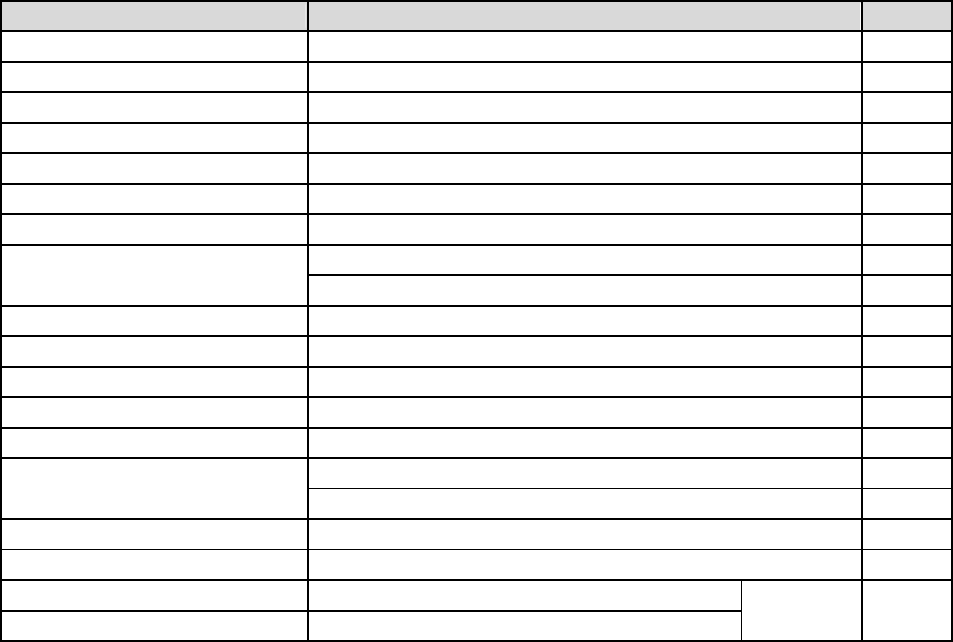
INSTALLATION GUIDE FOR RD-2020
RD-2020 CDMA QI Copyright - refer to title page Page 11
ENU Status : 1-0-0
2.4 KITS OF PART
For this system, the following are shipped:
Product Identifier Description Quantity
Allen Key 5.5mm 1
CPC Connector X14J7P 1
Clamp T3-099901-5202 2
Carriage Bolt (L>120) M12x160 4
Cable Gland Waterproof RJ45 cable gland 1
Ethernet Cable 2M 1
Fuse N/A 2
M8x20 6
Hex Socket Bolt M6x12 2
Key N/A 2
Lifting Ring T3-000201-5114 1
Masonry Bolt M10x110 4
Mounting Rack T3-099901-5201 1
Plain Washer Φ8 6
Φ8 6
Spring Washer Φ6 2
9-Pin Local Commissioning Cable R-9122C/ R-9122AC 1
O-Ring 7.1x1.8 8
User Manual RD-2020 QI
OMT V4.0 OMT Software on CD-Rom 1
Table 1: RD-2020 KOP
End of section
INSTALLATION GUIDE FOR RD-2020
RD-2020 CDMA QI Copyright - refer to title page Page 12
ENU Status : 1-0-0
3 INSTALLATION
3.1 WARNINGS AND ALERTS
Radio Frequency Energies
There may be situations, particularly for workplace environments near high-powered RF sources, where
recommended limits for safe exposure of human beings to RF energy could be exceeded. In such cases,
restrictive measures or actions may be necessary to ensure the safe use of RF energy.
High Voltage
The equipment has been designed and constructed to prevent, as far as reasonably, practicable danger.
Any work activity on or near equipment involving installation, operation or maintenance must be, as far as
reasonably, free from danger.
Where there is a risk of damage to electrical systems involving adverse weather, extreme temperatures,
wet, corrosive or dirty conditions, flammable or explosive atmospheres, the system must be suitably
installed to prevent danger.
Protective Earthing
Equipment provided for the purpose of protecting individuals from electrical risk must be suitable for the
purpose and properly maintained and used.
Handling Precautions
This covers a range of activities including lifting, lowering, pushing, pulling, carrying, moving, holding or
restraining an object, animal or person from the equipment. It also covers activities that require the use of
force or effort, such as pulling a lever, or operating power tools.
Where some of the abovementioned activities are required, the equipment must be handled with care to
avoid being damaged.
Electrostatic Discharge (ESD)
Observe standard precautions for handling ESD-sensitive devices. Assume that all solid-state electronic
devices are ESD-sensitive. Ensure the use of a grounded wrist strap or equivalent while working with
ESD-sensitive devices. Transport, store, and handle ESD-sensitive devices in static-safe environments.
INSTALLATION GUIDE FOR RD-2020
RD-2020 CDMA QI Copyright - refer to title page Page 13
ENU Status : 1-0-0
3.2 SITE PLANNING CONSIDERATIONS
Site Considerations
Outdoor equipment are designed to be waterproof, rainproof, and with snow protection. Temporary
protection should be taken when the equipment enclosure is opened for installation or maintenance in an
outdoor environment. The equipment must not be opened for installation or maintenance in bad weather
(e.g. gale, storm rainfall, extreme temperatures and high humidity).
Installation Location
Mounting surface shall be capable of supporting the weight of the equipment.
In order to avoid electromagnetic interference, a proper mounting location must be selected to minimize
interference from electromagnetic sources such as large electrical equipment.
Environmental
Humidity has an adverse effect on the reliability of the equipment. It is recommended to install the
equipment in locations having stable temperature and unrestricted air-flow.
The installation location for the product should be well ventilated. The equipment has been designed to
operate at the temperature range and humidity level as stated in the product specifications in the
datasheet.
Direct sun light exposure to the equipment should be avoided. Provide additional shelter if necessary.
Powering
The power supply unit (PSU) provides power to all modules within the equipment. Depending on the
product variant, it is recommended that the PSU operates on a dedicated circuit breaker or fused circuit.
Grounding Requirement
Verify that the equipment has been well grounded. This includes antennas and all cables connected to the
system. Ensure lightning protection for the antennas is properly grounded.
Cable Routing
Depending on equipment configuration, a variety of types of cables are required. Where applicable, ensure
cables are properly routed and secured so that they are not damaged.
Manual Handling
During transportation and installation, take necessary handling precautions to avoid potential physical
injury to the installation personnel and the equipment.
INSTALLATION GUIDE FOR RD-2020
RD-2020 CDMA QI Copyright - refer to title page Page 14
ENU Status : 1-0-0
3.2.1 INSTALLATION CHECKLIST
• Working space available for installation and maintenance for each mounting arrangement. Ensure
unrestricted airflow.
• Ensure earthing point is within reach of the ground wire.
• Ensure a power source is within reach of the power cord and the power source has sufficient capacity
(about 10A for 220/110VAC, 20A for +24VDC, 10A for -48VDC).
• Where appropriate, ensure unused RF connectors are terminated.
• Do not locate the equipment near large transformers or motors that may cause electromagnetic
interference.
• Reduce signal loss in feeder cable by minimizing the length and number of RF connections.
• Ensure VSWR of antennas system < 1.5:1.
• Ensure equipment will be operated within the stated environment (refer to datasheet)
• Observe handling of all cables to prevent damage.
• Donor antenna should have a narrow beamwidth positioned in line-of-sight (LOS) to donor BTS site so
that the donor signal level is maximized. This allows the use of minimum gain to achieve the maximum
DL output power. The UL gain is typically set lower than or equal to the DL gain to minimize noise
interference to the donor BTS.
• Service antenna should be selected based on the type of service area, e.g., indoor antenna for indoor
application, and panel antenna for outdoor application.
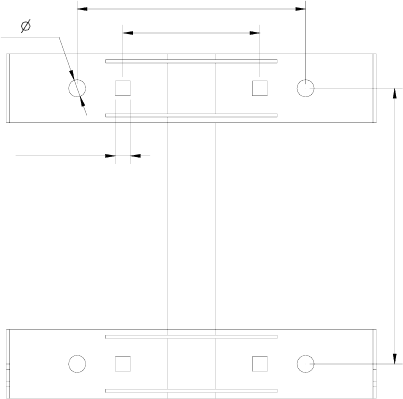
INSTALLATION GUIDE FOR RD-2020
RD-2020 CDMA QI Copyright - refer to title page Page 15
ENU Status : 1-0-0
3.3 INSTALLATION PROCEDURES
3.3.1 GOODS INWARDS INSPECTION
• Verify the number of packages received against the packing list.
• Check all packages for external damage and report any external damage to the shipping courier. If
damage occurs, a shipping agent should be present before unpacking and inspecting the contents
because damage caused during transit is the responsibility of the agent.
• Open and check each package against the packing list. If any items are missing, contact Comba.
• Do not remove items from antistatic packing until ready for installation. If damage is discovered at the
time of installation, contact the shipping agent.
3.3.2 INSTALLATION TOOLS
Refer to Appendix A for a full list of recommended tools required for installation.
3.3.3 MOUNTING RACK
The mounting rack is used for mounting the equipment to either a wall or on a pole. Shown below is the
diagram of the mounting rack. The round holes are used for masonry bolts, and square holes for carriage
bolts.
240
120
200
4-13*13
4- 15
Figure 4: Mounting Rack Dimension
The mounting rack is pre-installed with the equipment for shipment. It needs to separate the mounting rack
before commencing to wall or pole mounting.
Refer to Figure 8, use Allen key to unscrew M8x20mm hex socket bolts at 1, 2, 3, 4, 5, and 6 to separate
the mounting rack from the equipment.
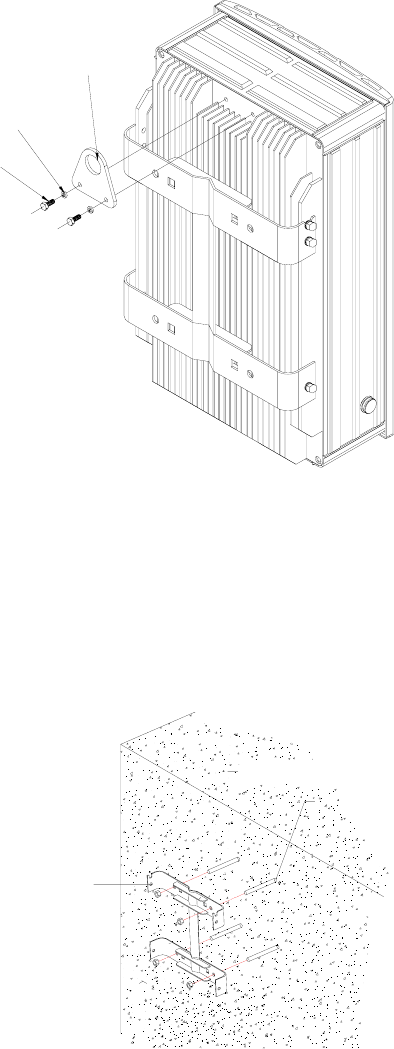
INSTALLATION GUIDE FOR RD-2020
RD-2020 CDMA QI Copyright - refer to title page Page 16
ENU Status : 1-0-0
3.3.4 LIFTING LUG INSTALLATION
This is provided to facilitate lifting and positioning of the equipment during installation. The lifting lug is to
be attached to the rear of the appropriate enclosure as shown below.
Spring Washer M6
Lifting Lug
Hex Bolt M6x12
Figure 5: Attach the Lifting Lug to the Enclosure
3.3.5 WALL MOUNTING DETAILS
• Drill four holes on the wall using the position of the four round holes in the mounting rack as a guide.
• Secure the mounting rack onto the wall where four holes have been drilled with four M10x110mm
masonry bolts.
Mounting Rack
Masonry Bolt
M10x110
Figure 6: Wall Mounting Overview

INSTALLATION GUIDE FOR RD-2020
RD-2020 CDMA QI Copyright - refer to title page Page 17
ENU Status : 1-0-0
3.3.6 POLE MOUNTING DETAILS
• The equipment can be mounted on poles of about 60~75mm in diameter.
• Secure the mounting rack onto the pole using M12x160mm carriage bolts and clamps through the
square holes.
• Tighten and lock M12 nuts together onto the carriage bolts.
M12x160
Carriage Bolt
Mounting Rack
Pole
M12 Nut
Clamp
Figure 7: Pole Mounting Overview
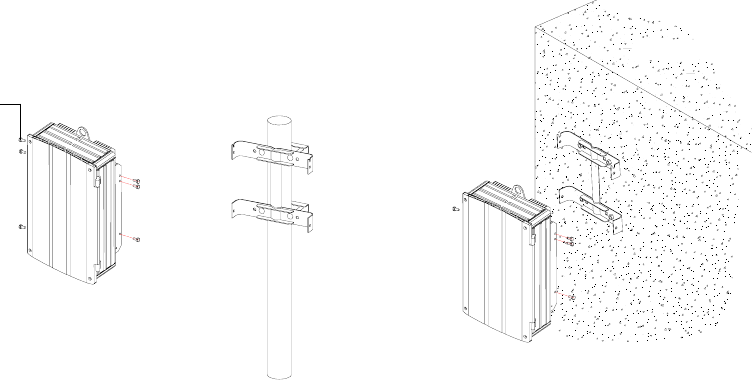
INSTALLATION GUIDE FOR RD-2020
RD-2020 CDMA QI Copyright - refer to title page Page 18
ENU Status : 1-0-0
3.3.7 ATTACHING EQUIPMENT ONTO MOUNTING RACK
• Located on the rear of the equipment enclosure are protruding vertical cooling fins.
• The two outer fins are designed for mounting the equipment onto the mounting rack; each of these fins
has steel threaded inserts already fitted.
• Partially thread the hex socket bolts onto the steel threaded inserts identified in the following drawing
as: ‘1’ and ‘4’.
• Lift the equipment and position it over the mounting rack, such that the hex bolts rests in their
designated locations on the mounting rack.
• Insert four more hex socket bolts ‘2’, ‘3’, ‘5’ and ‘6’ onto steel threaded insets to ensure the equipment
is firmly mounted.
• Tighten all hex socket bolts to secure the equipment onto the mounting rack.
M8x20 hex bolt
3
2
1
5
4
6
Figure 8: Attaching the Equipment onto the Mounting Rack
3.3.8 DRIP-LOOP
Comba recommends that every horizontal cable entry to the equipment forms a 'U' before its entry to the
equipment. Water on the cable will drip down at the bottom of the loop and will not accumulate at the
equipment connectors.
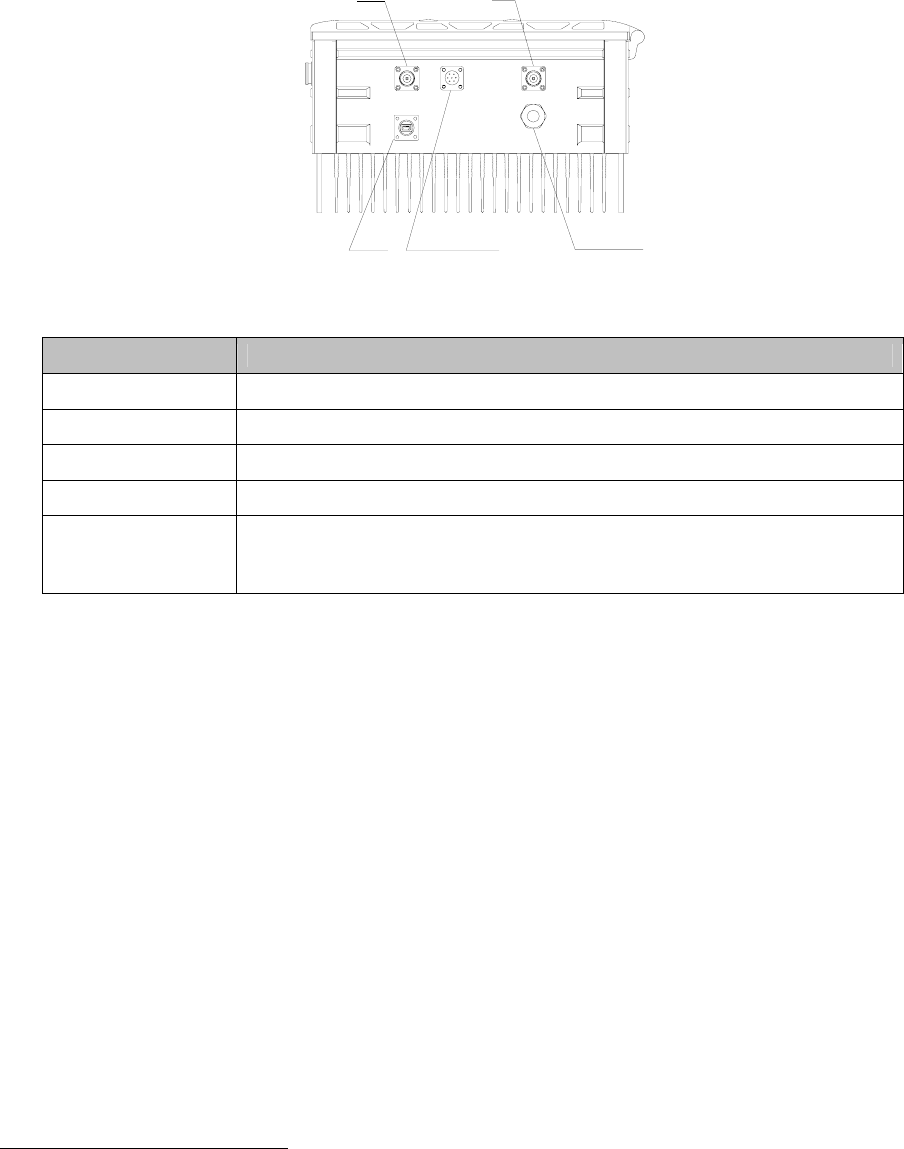
INSTALLATION GUIDE FOR RD-2020
RD-2020 CDMA QI Copyright - refer to title page Page 19
ENU Status : 1-0-0
3.4 EQUIPMENT CONNECTORS
The equipment has been designed for all cable entries from the bottom of the enclosure, as shown in the
following figure:
LAN POWER
DT MT
EXT_ALM
Figure 9: Equipment Connectors
Identifier Descriptions
DT N-Female connector for connection to donor antenna
MT N-Female connector for connection to service antenna
LAN Ethernet connector for connecting with Internet.
EXT_ALM 7-pin round connector for external alarm connection.
POWER 1 This is a power cable gland for a pre-installed power cord for connection
to AC or DC supply (e.g. 220V).
Table 2: RD-2020 Connectors
3.5 EQUIPMENT CONNECTIONS
3.5.1 GROUNDING CONNECTION
Ground Connection
To ensure safe operation of the product, a ground (earth) connection is required. For single phase AC
power source, the product must be grounded by connecting the “earth wire” of the power cord to the
ground terminal of the AC supply. For operating this product with DC power system (such as rectifiers), the
product should not be connected to power systems that switch open the return lead because the return
lead could function as the ground (earth) connection for the equipment.
Protective Ground Connection
The enclosure must be grounded securely by connecting a copper wire (CSA 16mm2) to the grounding
terminal on the equipment/rack, and the other end to a protective ground (i.e. building earth point). An
internationally acceptable colour code of the ground connection wire is green/yellow.
1 The voltage identification is a variant due to electricity system diversity of global regions. The power cable gland might
be identified for AC 220V, AC 110V, AC 220V/110V, DC -48V, or DC +24V respectively. Please refer to specific
product or contact local sales if any doubt.
INSTALLATION GUIDE FOR RD-2020
RD-2020 CDMA QI Copyright - refer to title page Page 20
ENU Status : 1-0-0
Such a ground connection implements the “Protective Ground Connection”, and must be connected to the
equipment at the designated ground point. In general, do not connect the supply before establishing an
adequate ground (earth) connection.
Construct the ground wire, and use appropriate crimp connectors where necessary. Locate and connect
the equipment grounding terminal to a protective ground (i.e. building earth point).
3.5.2 SERVICE VOLTAGE CONNECTION
The product accepts AC or DC power depending on the type of PSU installed.
• For AC PSU – The equipment accepts single phase 220/110VAC power. The recommended AC
connection is rated at AC220/110V, 10A and has three connections to include earth. The power cord
has been pre-wired to the PSU and led out via the power cable gland.
• For DC PSU – When the equipment is required to be DC powered, DC power connection from telecom
rectifier is via a wire with CSA of 2.1mm2. DC voltage supply is hard-wired to the rectifier equipment.
For planning purposes, allow DC current up to 20A and 10A to be drawn when powered with +24V
and -48V respectively. The wiring to telecom rectifiers is outside the scope of this document. Please
consult and observe the installation guidelines for telecom rectifiers.
y The DC power cable for -48V is colour coded, typically as BLUE for “-48V” or “Battery” and
BLACK for “0V” or “Return” connections.
y The DC power cable for +24V is colour coded, typically as RED for “+24V” or “Battery” and BLUE
for “0V” or “Return“connections.
y The power cord has been pre-wired to the PSU and led out via the power cable gland.
3.5.3 LI-ION BATTERY CONNECTION
Li-ion battery is provided with the product to ensure that power is supplied to the system monitoring unit
and MCU, and the alarm message can be sent out to the OMC effectively in case of mains power failure.
With the equipment lying flat, remove the bolts with an Allen Key, unlock and open the enclosure door.
Locate the battery pack. The in-line connector of the battery pack is “disconnected” from the PSU during
shipment. During installation, re-connect the in-line connector to activate the back-up supply to the MCU
board. Close the enclosure door, insert and tighten bolts to complete this procedure.
Caution: There is a risk of explosion if the battery is replaced by an incorrect type. Dispose of used
batteries according to the instructions.
3.5.4 RF CABLE CONNECTION
The connection of feeder cables is as follows:
z MT port → Connects to the feeder cable from service antenna
z DT port → Connects to the feeder cable from donor antenna
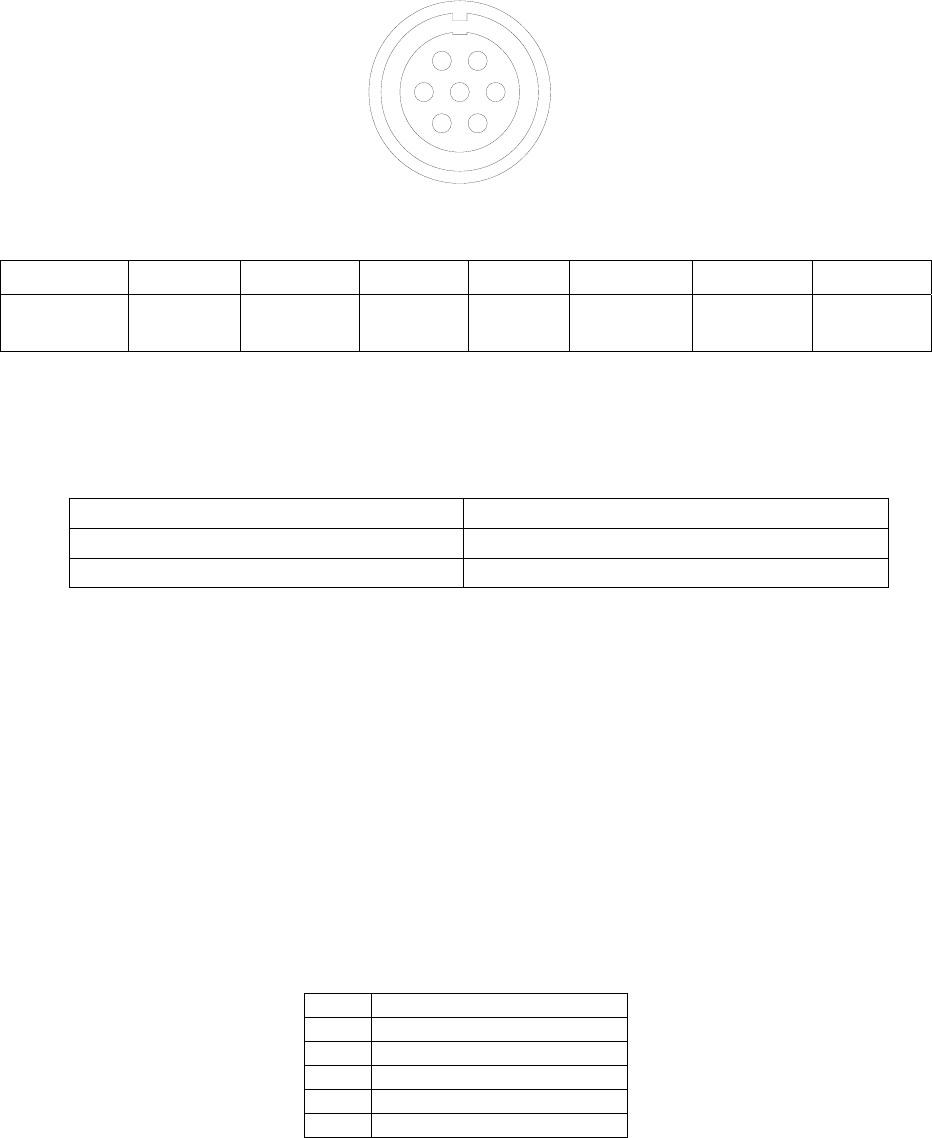
INSTALLATION GUIDE FOR RD-2020
RD-2020 CDMA QI Copyright - refer to title page Page 21
ENU Status : 1-0-0
3.5.5 EXT_ALM CONNECTION
Four alarm INPUT to RD-2020 are realized on the EXT_ALM port, this is a 7-pin round connector. The
following figure and table shows the pin allocation and definition. Pin numbering are shown looking-into the
connector on the enclosure.
7
6
35
4
12
Figure 10: Pins Allocation for 7-pin EXT-ALM Connector
Pin number 1 2 3 4 5 6 7
Alarm
definition
EXT.
Alarm 1
EXT.
Alarm 2
EXT.
Alarm 3 GND EXT.
Alarm 4 Reserved Reserved
Table 3: External Alarm Signal Definition
These signals are defined as “TTL/CMOS level”, for RD-2020, the following voltage are valid as EXT_ALM
signals:
Voltage as applied to EXT Alarm pin Alarm Condition as Seen by the RD-2120
0V to 1.5V Alarm recognized
3.5V to 5V No Alarm recognized
Table 4: Voltage Applied to EXT Alarm Pin
3.5.6 RJ45 WATERPROOF CABLE CONNECTION
The RJ45 waterproof cable connection includes a waterproof cable plug, which needs to be disassembled
as below.
No. Description
1 Plastic O-ring
2 Body
3 Nut
4 Ring
5 Sealing nut
Pull the Ethernet cable through all components of the plug and terminated with RJ45 connecter with
crimper. Pull the connecter to the end of the plug and then screw the plug.
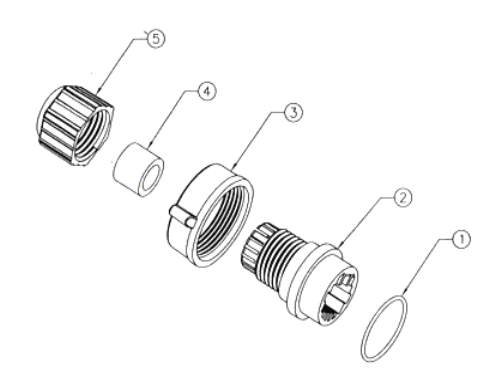
INSTALLATION GUIDE FOR RD-2020
RD-2020 CDMA QI Copyright - refer to title page Page 22
ENU Status : 1-0-0
Figure 11: RJ45 Waterproof Cable Plug

INSTALLATION GUIDE FOR RD-2020
RD-2020 CDMA QI Copyright - refer to title page Page 23
ENU Status : 1-0-0
3.6 PREPARATION FOR REMOTE CONTROL OF EQUIPMENT USING
MODEM
Wireless Modem (Optional)
For the equipment variant equipped with wireless modem, the modem provides the option of remote
connection of the equipment to the OMT. The wireless (GSM) modem implements the link for data and
SMS.
Note: When CDMA modem is used, only SMS function is supported to retrieve alarm information and to
provide remote control.
The power and data cables have been factory-connected to the wireless modem. User needs to insert the
SIM / UIM card to the GSM / CDMA modem.
To insert or replace the SIM / UIM card, locate and press down the recessed button (yellow) to eject the
SIM / UIM card carrier (refer to the following figure). Insert the SIM / UIM card and push back the carrier
until it is latched in place.
SIM card
SIM card carrier
Yellow button
Indicator LED
Modem RF output
(SMA connector)
RS232 port
Power port
SIM card
SIM card carrier
Yellow button
Indicator LED
Modem RF output
(SMA connector)
RS232 port
Power port
Figure 12: Wireless Modem
The LED indicator on the wireless modem displays the state of the modem:
z LED OFF: equipment power off
z LED ON: equipment power on, no SIM/ UIM card or no connection to antenna
z LED flash slowly: equipment power on, in SMS mode
z LED flash quickly: equipment power on, in data link mode
Note: Data link mode is dependent on service availability from service provider. If it is required, the
operator’s SIM card must be data-enabled (Circuit Switch Data) and without PIN code.
End of section

INSTALLATION GUIDE FOR RD-2020
RD-2020 CDMA QI Copyright - refer to title page Page 24
ENU Status : 1-0-0
4 COMMISSIONING
4.1 PRE-COMMISSIONING
After equipment installation, perform the following steps before equipment powering and commissioning.
Verify the incoming power source voltage, current, and power levels do not violate any ratings. Double
check all connections before applying power. Do not manipulate circuits or make changes with power
applied.
• Visually inspect the power connection within the equipment. Ensure that the power cable is correctly
and securely connected, including grounding wire and RF cable.
• Check grounding connection and verify that the ground resistance is less than 5Ω.
• Connect the equipment with OMT software.
• With the equipment installed and cables connected, apply power to it by switching on the PSU switch.
• Monitor the initialization of the equipment through the indicator LEDs on the MCU. Refer to detailed
LEDs information in the next section.
4.2 MCU LED INDICATORS
Three diagnostic LEDs are located on the MCU board, each indicating the status of a particular function:
Identifier Colour Indication
H1 Green MCU operation. Flashing at a rate of 1 flash/sec. Any other flashing rate
indicates MCU is faulty, and has to be replaced.
H2 Red Warning LED. When ON, it indicates alarm condition.
H3 Red Wireless modem status. During normal operation, it is OFF. When ON, it
indicates faulty wireless modem and no communication will take place.
Table 5: LED Description
All the three diagnostic LEDs will flash simultaneously for three times when power is supplied to the
equipment. Then H1 will keep flashing at the rate of 1 flash/second. H2 will be ON when any alarm occurs.
H3 will be ON and will turn OFF two minutes after successful initialization of the modem; otherwise, it will
remain ON.
H3H2H1
MCU
Connector to distribution board
Push-button
switch
Figure 13: MCU LED Indicators
On the MCU there is a push-button switch (usually yellow) used to manually reset the equipment when
equipment initialization fails, or any ab-normal operation happens, or when the equipment is re-connected
to the OMT after powered off due to some reason.

INSTALLATION GUIDE FOR RD-2020
RD-2020 CDMA QI Copyright - refer to title page Page 25
ENU Status : 1-0-0
4.3 WEB OMT
4.3.1 CONNECTION FROM PC TO EQUIPMENT
Before accessing to the OMT, physical connection between the OMT software and the equipment must be
made. A straight-through RJ45 cable shall be applied for the connection.
In order to access to equipment by IP protocol, the PC must be set with proper IP address, subnet mask
and gateway.
Figure 14: PC Protocol Setting
The default IP address of repeater is 192.168.1.2, and default gateway is 192.168.1.1. To access the
repeater for the first time, the PC must be set with proper IP address: 192.168.1.X (X=3~254), subnet
mask: 255.255.255.0, gateway: 192.168.1.1.
After the PC protocol has been properly set, please execute the IE browser and type 192.168.1.2 in the
address bar. A pop-up window will be shown, requiring user name and password. The default user and
password are the same: admin.
Figure 15: Log in

INSTALLATION GUIDE FOR RD-2020
RD-2020 CDMA QI Copyright - refer to title page Page 26
ENU Status : 1-0-0
Items Default Value
PC IP Address 192.168.1.X (X=3~254)
PC Subnet Mask 255.255.255.0
PC Gateway 192.168.1.1
Repeater IP Address 192.168.1.2
Repeater Gateway 192.168.1.1
User name admin (Capital sensitive)
Password admin (Capital sensitive)
Table 6: IP Setting Quick Look-up Table
If the user name and password have been entered properly, then the OMT webpage will be shown as
below.
Figure 16: Alarm Information
The alarm information page will be shown as the first page whenever log in. The alarm history will be
reserved in repeater until 24 hours after its first power on, and then automatically cleared up. Before its
auto clear-up once a day, to manually refresh the alarm status please goes to “User Info & Maintenance”
page as below and click “Clear History Alarm”. Below are the definitions for different buttons and functions.
Items Functions
24 Hours The “24 hours” defines a standard reset timing after repeater first power on.
This founction is designed for routined self-maintenance and alarms clear-up.
Read Read alarm history from repeater. Any alarm has been detected, it will be kept
in history until next alarm reset per 24 hours.
Refresh Refresh local web page to check which items are selected, but no data read
from repeater.
Clear History Alarm Clear the alarm history manually.
Figure 17: User Info& Maintenance
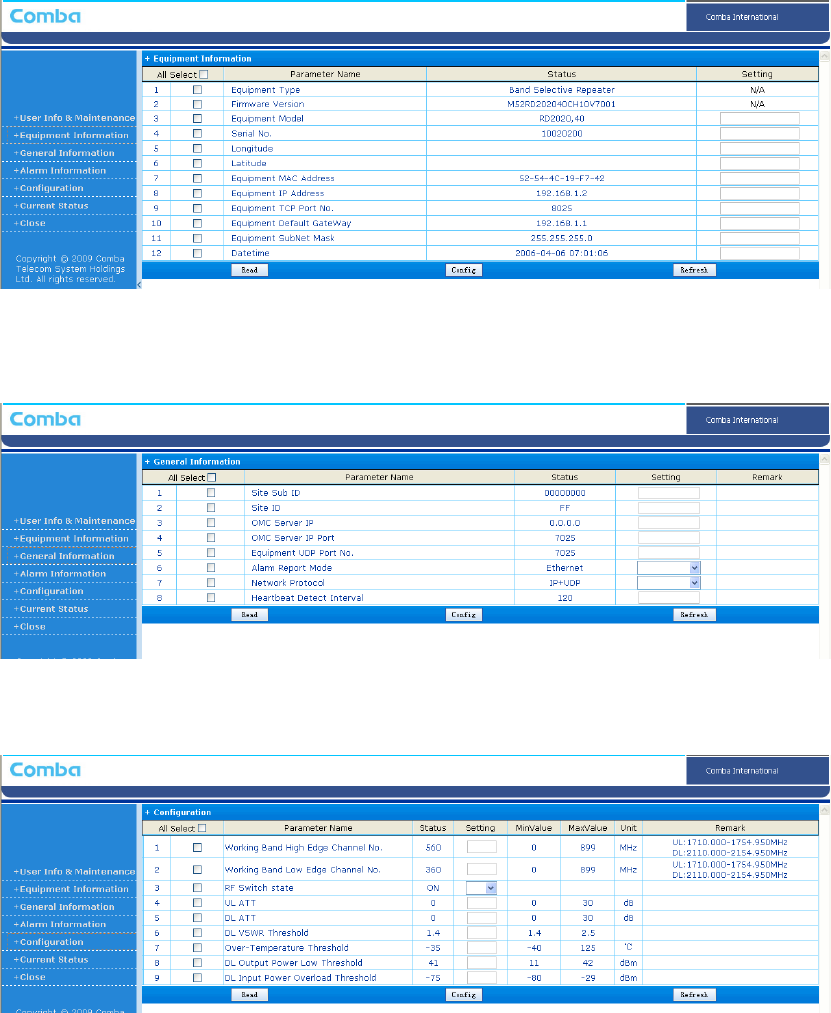
INSTALLATION GUIDE FOR RD-2020
RD-2020 CDMA QI Copyright - refer to title page Page 27
ENU Status : 1-0-0
User can access to different sub-titles on the left part of the page.
The “Equipment Information” page contains basic information of the repeater such as firmware version,
product model, serial No. etc.
Note: The IP network parameters of the repeater can be modified from this page.
Figure 18: Equipment Information
The “General Information” page is mainly for setting up the communication between repeater and other
remote device such as OMC and mobile phone to receive alarm message.
Figure 19: General Information
The “Configuration” page is for setting the RF parameters.
Figure 20: Configuration
The “Current Status” shows the status of the running equipment and cannot be modified.

INSTALLATION GUIDE FOR RD-2020
RD-2020 CDMA QI Copyright - refer to title page Page 28
ENU Status : 1-0-0
Figure 21: Current Status
4.4 COMMISSIONING PROCEDURE
System commissioning can commence after the monitoring system has completed self initialization. The
commissioning procedure is as follows:

INSTALLATION GUIDE FOR RD-2020
RD-2020 CDMA QI Copyright - refer to title page Page 29
ENU Status : 1-0-0
Commissioning Tasks Observation
1. On-line and Inquiry status z Connect to repeater from PC via OMT.
2. Set Channel No.
z Keep RF switch ON and set the channel number of the repeater’s
operating frequency.
3. Adjust Downlink Output
Power and align donor
antenna
z Observe DL input power from measured value. Align the direction of
donor antenna until the DL input power reading is maximized.
z Note: To ensure that the measured DL input power is accurate, one
should set the DL ATT to “0” before performing the check.
4. Configure [Equipment ID] z Go to [Properties Info] and set [Equipment ID].
5. Comm. Config
z Enable the power supply by selecting “On” in [RF] -> [Switch]; go to
[Properties Info.] -> [Comm. Config.] and set OMC Phones No. , the
service No. of SMSC, Report Mode.
6. Select Monitoring
Parameters
z Select the equipment controlled and monitored parameters.
z If the external devices are connected to the equipment for
management, please enable in the [External Alarm Info.] Interface.
7. Test coverage area field
intensity and adjust
service antenna.
z Use test-handset to verify field intensity within the coverage area. If
needed, realign the service antenna to achieve the desired
coverage.
z Note: If during operation, the equipment gain could not be set to
maximum or the output power is not high enough due to insufficient
donor and service antennas isolation, then the antennas’ position
should be changed to increase isolation. If the output power is too
high and ALC is activated, then adjust the DL ATT to achieve
optimal DL Gain.
8. Verify UL gain and ensure
test call produces good
voice quality and there is
no interfering BTS
z Adjust UL gain and perform test calls. Typically, the UL gain is set
around 5dB less than DL gain. Perform test calls in the coverage
area while adjusting UL gain if required.
z Note: If the repeater is near the BTS and the test call performance
is poor, this may be due to UL noise interference to the BTS. Users
can calculate and determine if the repeater UL noise will interfere
with the BTS.
z Verify again that there is no unacceptable interference to BTS.
Table 7: Commissioning
End of section
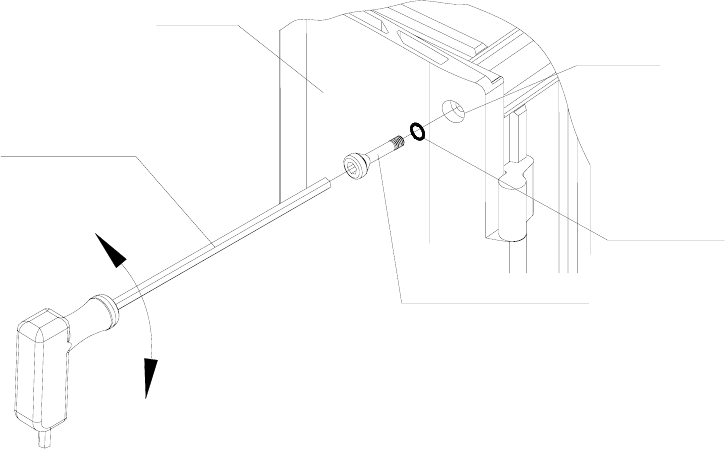
INSTALLATION GUIDE FOR RD-2020
RD-2020 CDMA QI Copyright - refer to title page Page 30
ENU Status : 1-0-0
5 MAINTENANCE
The system is designed for trouble-free operation and generally does not need maintenance. Maintenance
activities should only be carried out by trained personnel.
The equipment operation status can be observed remotely through the OMT/OMC.
Periodic inspection of the equipment(s) is recommended. The recommended tasks include:
• Measurement of the return loss of the feeder system.
• Ensure the reliable connection of cables, power cords and facilities located indoor.
• Inspect and record operation status and parameters, such as receive signal level, output noise level,
DL output power of the equipment, from OMC or OMT.
• Check the PSU output voltage.
• Verify that the actual coverage has not degraded.
• Check the controlling and monitoring function.
• Verify that lightning and grounding protection is in good condition.
• Ensure the labels are clear and legible.
• For Li-ion battery, verify their state. Deeply discharged battery should be returned to the Factory for
replacement. If the battery voltage drops under 16V within one hour, replacement of Li-ion battery is
recommended.
5.1 O-RING FITTING DETAILS
The “O” ring serves as an effective alternative to prevent the countersunk door bolt from becoming loose
and as a waterproof feature. The “O” rings have already been fitted with the equipment before shipment,
and spare “O” rings are also provided for replacement. When necessary, users can replace the worn out
“O” rings with the spare ones. The following figure illustrates how the “O” ring is fitted with the equipment
enclosure.
Enclosure
5.5mm Allen Key
Enclosure Screw M6x35
O-Ring 7.1x1.8
Bored hole
Figure 22: O-Ring Fitting Details
End of section
INSTALLATION GUIDE FOR RD-2020
RD-2020 CDMA QI Copyright - refer to title page Page 31
ENU Status : 1-0-0
6 APPENDICES
6.1 APPENDIX A: TOOLS AND EQUIPMENT FOR INSTALLATION
The following are the recommended list of tools for new installation and routine maintenance:
• Slotted screwdriver
• Philips screwdriver
• Ring spanner (Assorted size: 12~20mm)
• Electrically operated drill and masonry drill bits ∅12mm
• Anti-static wrist strap
• Allen key (M5.5)
• Side Cutter
• Frequency counter (e.g. FLUKE PM6685R)
• RF Power Meter (e.g. Bird 5000)
INSTALLATION GUIDE FOR RD-2020
RD-2020 CDMA QI Copyright - refer to title page Page 32
ENU Status : 1-0-0
6.2 APPENDIX B: SERVICING POLICY AND RETURN OF EQUIPMENT
The repair of individual units and modules of this equipment is not considered practicable without factory
facilities. It is, therefore, the policy of Comba whereby faulty units or modules are returned to the local
agent for repair.
To enable an efficient, prompt after sales service to be provided for the diagnosis, repair and return of any
faulty equipment, please comply with the following requirements.
Items to be sent for repair should be packaged so as to provide both electrostatic and physical protection
and a Repair Material Authorization (RMA) should be completed giving the required information. A sample
RMA form is provided in Appendix.
This request must be included with the item for repair. Items for repair should be sent to the nearest
Comba office:
COMBA TELECOM LTD.
Hong Kong Office
Address: 611 East Wing, No. 8 Science Park West Avenue, Hong Kong Science Park, Tai Po, Hong Kong.
Tel: +852 2636 6861 Fax: +852 2637 0966
Singapore Office
Address: No. 1 Kaki Bukit View, #02-10 Techview, Singapore 415941
Tel: + 65 6345 4908 Fax: + 65 6345 1186
Thailand Office
Address: 3rd Floor, T. Shinawatra Building, 94 Sukhumvit Soi 23, Sukhumvit Road, Klongtoeynua,
Wattana, Bangkok 10110
Tel: +66 2664 3440 Fax: +66 2664 3442
India Office
Address: Suite No. 2, E-172, TSH House, Greater Kailash – I, New Delhi – 110 048, India
Tel: + 91 11 4173 9997 / 8 Fax: + 91 11 4173 9996
Sweden Office
Address: Gustavslundsvagen 147, S- 167 51 Bromma, Stockholm, Sweden
Tel: +46 8 25 38 70 Fax: +46 8 25 38 71
Brazil Office
Address: Avenida Engenheiro Luiz Carlos Berrini 1297, cj 122, 04571-090 Brooklin Novo, São Paulo,
Brazil
Tel: +55 11 35093700 Fax: +55 11 35093720
Dubai Office
Address: P.O. Box 450583, DUBAI, U.A.E.
Tel: +971 0 4 433 5320 Fax: +971 0 4 422 6774
US Office
Address: Comba Telecom Inc. 2390 Bering Drive, San Jose, CA 95131, USA
Tel: +1 408 526 0180 Fax: +1 408 526 0181
China Office
Address: No.10, Shenzhou Road, Guangzhou Science City, Guangzhou, China
Tel: + 86 20 2839 0000 Fax: + 86 20 2839 0136
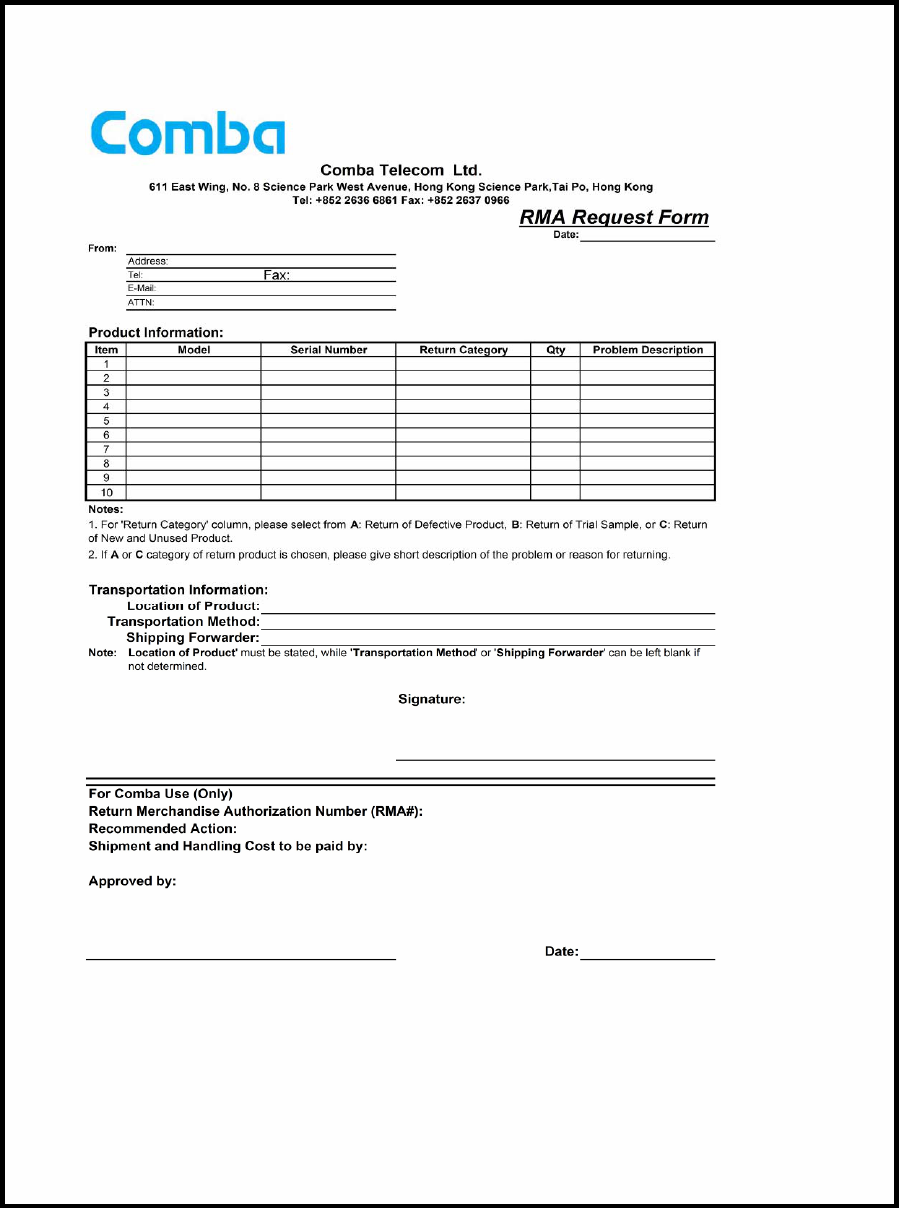
INSTALLATION GUIDE FOR RD-2020
RD-2020 CDMA QI Copyright - refer to title page Page 33
ENU Status : 1-0-0
6.3 APPENDIX C: RMA (RETURN MATERIAL AUTHORIZATION) FORM
End of section
End of Document